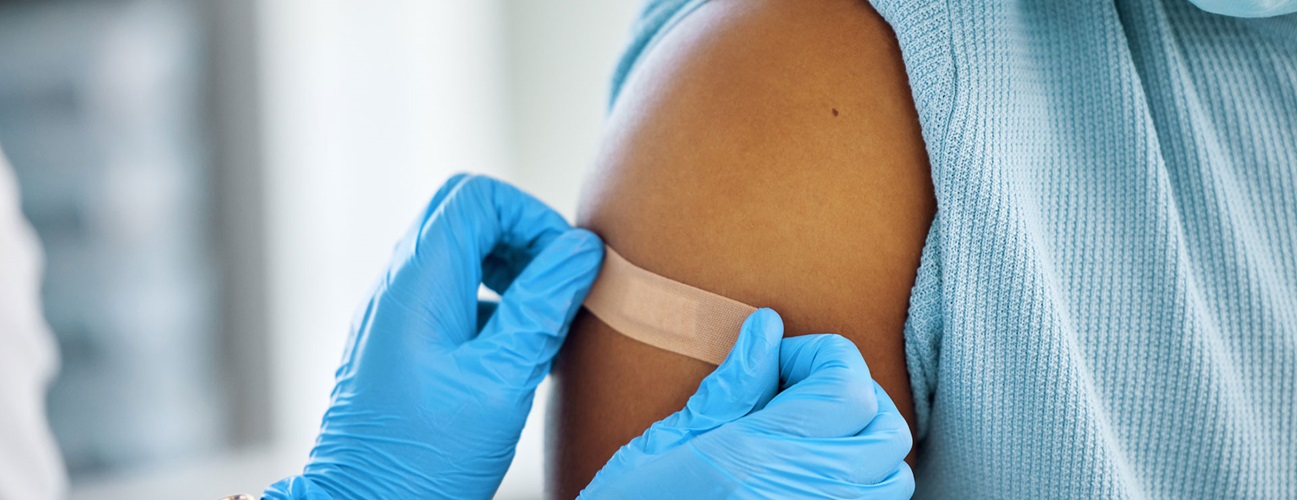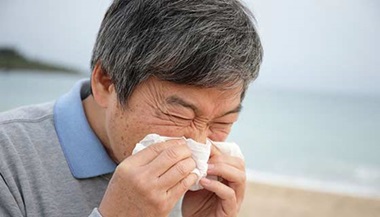Vaccines
Vaccines help your body fight disease and can help prevent or lessen the impact of illness.
What is a vaccine?
A vaccine is a medical treatment that helps your body’s immune system recognize and fight disease.
Vaccine Terms to Understand
- Vaccination is getting or giving a vaccine (injection, oral or nasal spray) to prevent infectious disease.
- Immunity means your body has been exposed to a germ (or part of it, or something that mimics it) and your immune system has developed antibodies to fight it. When you are immune to a germ, it will not make you sick if you encounter it again.
- Immunization is the process of your body becoming resistant to a germ (pathogen) after you get a vaccine.
- Inoculation is introducing a pathogen or vaccine to the body to help someone develop immunity to a disease.
- Pathogens are what we commonly call germs: the viruses, bacteria, fungi, parasites and other microbes that can enter our bodies and cause infection and illness.
- Antigens are anything present in the body that the immune system recognizes as an invader and tries to fight. Vaccines put antigens into the body.
- Antibodies are Y-shaped proteins produced by immune cells in the body to fight pathogens. Most people have hundreds of millions of different kinds of antibodies.
How do vaccines work?
A vaccine introduces the body to an ingredient that mimics the appearance or behavior of a pathogen that could make you sick.
Those ingredients are called antigens. An antigen might be a germ that has been killed or changed so it cannot cause disease. It can be something that looks or behaves like a pathogen, a harmless part of a pathogen, or instructions for the body to manufacture the harmless part.
When the body encounters the antigen in a vaccine, the immune system responds to the antigen and recognizes it as an unwanted invader. It creates specific defenses called antibodies that work against that particular pathogen.
Later, if the body encounters the whole, active germ in the environment, the immune system is prepared to respond quickly to fight it and help the person resist disease.
What does a vaccine do?
When you are vaccinated, the antigen enters your body. Special cells called antigen-presenting cells, or APCs, circulate throughout the body looking for invaders.
When an APC encounters the antigen from the vaccine, it consumes it. Then, the APC displays a part of the antigen on its outer wall, like a trophy that other cells in the immune system can detect.
The APC, with the antigen part on its outer surface, reports to areas of the immune system such as the lymph nodes, where cells called T-cells are found. The T-cells, which include helper T-cells, are activated and alert other cells to fight the antigen.
B-cells are another weapon of the immune system. These cells recognize the antigen when activated by the T-cells, or simply by encountering antigens in the body.
Others are plasma B-cells, which produce antibodies the body uses against the pathogen. Antibodies are Y-shaped proteins created in huge numbers by the plasma B-cells. They interact with and bind to antigens, and either destroy them or make it so that they cannot enter a cell and cause disease.
Some vaccines contain a weakened (attenuated) form of a particular bacterium or virus, which enters cells in the body. Killer T-cells, informed of the antigen’s presence by the APCs, then destroy those infected cells.
Memory cells such as memory B-cells, memory helper T-cells and memory killer T-cells make sure that the immune system will recognize if the real pathogen appears. When the immune system is triggered a second time by the same antigen, it responds with more speed and strength to destroy the invader, creating even more antibodies and memory cells to fight it.
Can I still get sick if I have been vaccinated?
In some cases, yes. Whereas some vaccines effectively block illness, other vaccines only prevent the most severe form of a disease.
An example is the COVID-19 vaccine, which does not keep you from getting infected with the coronavirus that causes COVID, but can help prevent you from getting dangerously sick from that virus.
Another example is influenza: You might get the flu even when you’ve received a flu shot. This is because each season, flu viruses change (mutate). There are many flu viruses circulating. The yearly flu shot only protects you from the three or four most severe ones: that’s all manufacturers can “fit” into that year’s flu vaccine. You may still get infected with a milder flu virus that wasn’t included in the shot.
Vaccine Types
There are several types of vaccines that are made using different technologies.
Live Attenuated Vaccines
These vaccines contain weakened versions of viruses or, less commonly, bacteria. Manufacturers isolate the pathogen and grow it in a lab until the pathogen loses its ability to cause disease. They select the weakest ones and reproduce them to put in the vaccine.
Live attenuated vaccines can produce a strong immune response, which can mean both long-term immunity and a higher chance of side effects. They may not be safe for people with impaired immune systems, who could develop a full-scale infection from even weakened viruses or bacteria.
Examples of live attenuated vaccines: measles, mumps/rubella (MMR), smallpox, chickenpox vaccines and rotavirus vaccine
Inactivated Vaccines
Many of the first vaccines were created this way. After isolating the virus or bacterium, manufacturers grow a large population of these germs and treat them with heat or chemicals to inactivate them before putting them into vaccines.
Though inactivated vaccines may cause fewer or less intense side effects, they may result in less robust immunity than a live attenuated vaccine and may require booster shots.
Examples of inactivated vaccines: hepatitis A, some forms of flu, polio and rabies vaccines
Subunit (Recombinant, Polysaccharide or Conjugate) Vaccines
After isolating and growing the germs, vaccine manufacturers isolate a part of it (such as a protein, a sugar or part of its surface) that is harmless by itself but is recognized by the immune system as an invading antigen.
This part (which is harmless on its own) is manufactured and put it into a vaccine that activates the immune system against the entire pathogen if it enters the body.
Because vaccine makers only use a part of the pathogen, these vaccines can be safer for people with weakened immune systems.
Examples of subunit vaccines: pertussis (whooping cough), hepatitis B, shingles, meningitis and human papillomavirus (HPV) vaccines
Messenger RNA (mRNA) Vaccines
Some vaccines contain instructions to your cells to create a part of a virus, which cannot cause disease on its own.
Messenger RNA is a molecule that tells our bodies to make proteins. mRNA from a virus tells our cells to make harmless proteins just like those on a harmful virus.
The presence of the pathogen part in your body triggers your immune system to create antibodies that protect you from that virus.
Examples of mRNA vaccines: the two-dose COVID vaccines
Toxoid Vaccines
Some bacteria release toxic substances. Some of these toxins can be made into toxoids by isolating and modifying them so they are not harmful. A vaccine that contains a small amount of toxoid can help a person’s immune system learn to fight the bacterium.
Examples of toxoid vaccines: tetanus and diphtheria vaccines
Viral Vector Vaccines
Viral vector vaccines use a harmless deliverer (vector), such as a type of adenovirus. To make the vaccine, an adenovirus is loaded with information that informs cells how to manufacture a look-alike, harmless part of the disease-causing virus.
The vaccines deliver “directions” from the vector, telling cells how to create copies of the harmless part of the virus. The cells make copies of the part, which accumulate in the body, triggering the immune system to create antibodies to fight them.
Cancer Vaccines
Exciting new developments in research are using vaccines to supercharge the immune system to fight certain kinds of cancer. For instance, a vaccine for pancreatic cancer uses principles of immunotherapy to help the immune system recognize and destroy cancerous cells.
Whereas most vaccines are given to produce immunity and prevent disease, cancer vaccines may help treat cancer when a person already has it.
How are vaccines made?
A new vaccine goes through several stages of development and testing to ensure it is safe for the public.
Exploratory Stage
Laboratory researchers funded by industry, the government, academic foundations or other groups can take two to four years or more to identify a natural or manufactured antigen that could help humans’ immune systems fight a particular pathogen.
Pre-Clinical Stage
The vaccine is tested by government, academic or industry researchers on cells, tissues and sometimes animals to see if it causes an immune response. If it fails, which most vaccine candidates do, the whole project might end here. But, if the results look promising, at this stage, researchers calculate an appropriate dosage to be tested on human volunteers. The pre-clinical stage can last several years.
IND Application
A private company or other sponsor submits an Investigational New Drug (IND) application to the U.S. Food and Drug Administration (FDA). The application describes the research behind the vaccine, its proposed manufacturing process, and the plan and study design for clinical testing.
Clinical Development
- During Phase I, the vaccine is tested for safety and effectiveness among small groups of volunteers (fewer than 100).
- If Phase I results show that the vaccine works and is safe, it is then tested on larger groups with hundreds of volunteers, including those with similar characteristics to people who are most likely to use the vaccine, such as people of a certain age (Phase II).
- Continued encouraging results prompt Phase III, which involves testing with large groups of volunteers consisting of thousands of people.
- All vaccines continue to be tested even after they are authorized or approved (Phase IV testing).
Regulatory Review and Approval
In the United States, the FDA regulates, authorizes and approves new vaccines based on the clinical trial results. The FDA continues to monitor vaccines as they are used, inspects manufacturing process and facilities, and conducts its own tests on vaccines from time to time.
The Vaccine Adverse Event Reporting System (VAERS)
VAERS is a cooperation between the Centers for Disease Control and Prevention and the FDA to collect data around any unexpected problems a vaccine causes in people.
Vaccine Manufacturing
To make the actual vaccines, manufacturers combine the active ingredient (the antigen) with purified water and stabilizers such as sugars, gelatin or protein derived from yeast.
Some manufacturers might add a preservative that has been carefully tested and proven safe (2-phenoxyethanol) so the vaccine can be shipped and stored without losing its effectiveness.
Surfactants (used in many foods) keep the vaccine ingredients blended.
Some vaccines contain adjuvants, which help elicit the immune response.
How long does it take to make a vaccine?
Depending on the pathogen, it can take anywhere from several months to multiple decades to create, test, manufacture and distribute a new vaccine.
A new pathogen that causes serious or contagious disease can cause a pandemic, which is a public health emergency. Newly evolved (novel) viruses and bacteria are a dangerous risk since human beings have no immunity to them and scientific researchers have no information on how these pathogens spread or behave.
The relatively quick development of vaccines (such as the ones for COVID) does not mean safety measures were skipped. There are several reasons why the COVID-19 vaccines were developed faster than other vaccines:
- The technologies used to develop the covid vaccines have been in development for years to prepare for outbreaks of infectious viruses. The manufacturing processes were ready very early in the COVID pandemic.
- Countries shared genetic information about SARS-CoV-2, the coronavirus that causes COVID-19, which gave vaccine developers an early start at finding a vaccine.
- The testing processes for the vaccines didn’t skip any steps, but the vaccine developers conducted some stages of the process at the same time instead of one after the other. This helped them gather data as quickly as possible.
- Governments gave money to vaccine developers in advance, so the companies had resources they needed.
- Some types of COVID-19 vaccines were created using messenger RNA (mRNA), which takes less time to make than the traditional way vaccines are made.
- Social media enabled companies to reach out to and enroll study volunteers, and plenty of people wanted to help, so there were enough research participants to test the vaccines.
- Because COVID is so contagious and widespread, many volunteers who got the vaccines were exposed to the virus, and with so many exposures, it took a shorter time to see if the vaccines worked.
- Companies began manufacturing vaccines ahead of their authorization or approval so some supplies would be ready when authorization occurred.
Learn more about COVID-19 vaccines.
Why isn’t there a vaccine for HIV or the common cold?
Vaccines can be created for many viruses, but there are some that present very difficult problems.
For instance, the virus that causes HIV is unusual because it has a way of making itself invisible to the immune system. If the immune system cannot identify the virus, it is hard to teach it to respond to an antigen in a vaccine.
We might think of as a common cold is one illness, but colds can be caused by any of hundreds of different viruses. Developing a vaccine that only protects you from a few of them isn’t likely to keep you from coming down with a cold since there are so many others in circulation.
Why do I have to get a flu shot every year?
Influenza (the flu) is a common illness that sickens millions and kills thousands of people every year. It is caused by a set of viruses that are very likely to change (mutate).
Each year, the vaccine makers isolate the flu viruses that are most likely to cause serious disease, as well as those that are the most contagious. The three or four most dangerous flu viruses that are circulating during a particular year are used to make that year’s vaccine. If you do get the flu after having been vaccinated, it is less likely to be severe.
Are vaccines safe?
Yes. In the U.S., vaccine safety is a high priority. The process of developing new vaccines and making them available is highly regulated, with federal agencies working with vaccine manufacturers to ensure that the vaccines work properly and are safe for the public.
Careful testing. All vaccines go through clinical trials to test safety and effectiveness, with high standards set by the FDA for vaccine developers to meet. This infographic from the National Institutes of Health shows the steps a vaccine must go through before it is approved or authorized for people to use.
Authorization for emergency use. When a vaccine meets safety and efficacy standards, the FDA can make the vaccine available in the United States by approving it or by authorizing it for emergency use. An emergency use authorization makes a vaccine or medication available for an emergency situation, such as a new virus that is contagious or causes serious disease.
Continuous monitoring. Even when the FDA approves or authorizes a vaccine, they work with the vaccine manufacturers and continue to watch for any problems and side effects that did not show up during the clinical trials.
Do vaccines cause side effects?
Sometimes. When a vaccine triggers a response from your immune system, immune cells go to work to fight the antigen. If there is a strong immune reaction, you might feel tired or experience body aches, headache, swollen lymph nodes (glands) or even a fever.
These side effects seldom last more than a day or two and do not mean you are sick. They signify that the vaccine has successfully activated your immune system.
If you do not have any symptoms, it does not mean that the shot was unsuccessful. A vaccine without side effects can still activate your immune system and protect you from disease.
What vaccines do I need?
You and your primary care doctor or local health clinic can discuss which vaccines are appropriate for you and your family, and the best time to get them.
Once you have a recommended vaccine schedule from your primary care provider, it is important to keep up with it. Making sure your children’s vaccines stay up to date can keep them from potentially serious ― even deadly ― preventable diseases.
Though most of your vaccines can be scheduled with your doctor’s help, there are times when you might need a special vaccine to protect you from illness. Some examples would be if you were at risk for rabies from an animal bite or tetanus due to a severe skin wound.
If you are planning to visit certain areas of the world where different pathogens are commonplace, you may be required to show proof of vaccines for travelers before you enter those areas.





